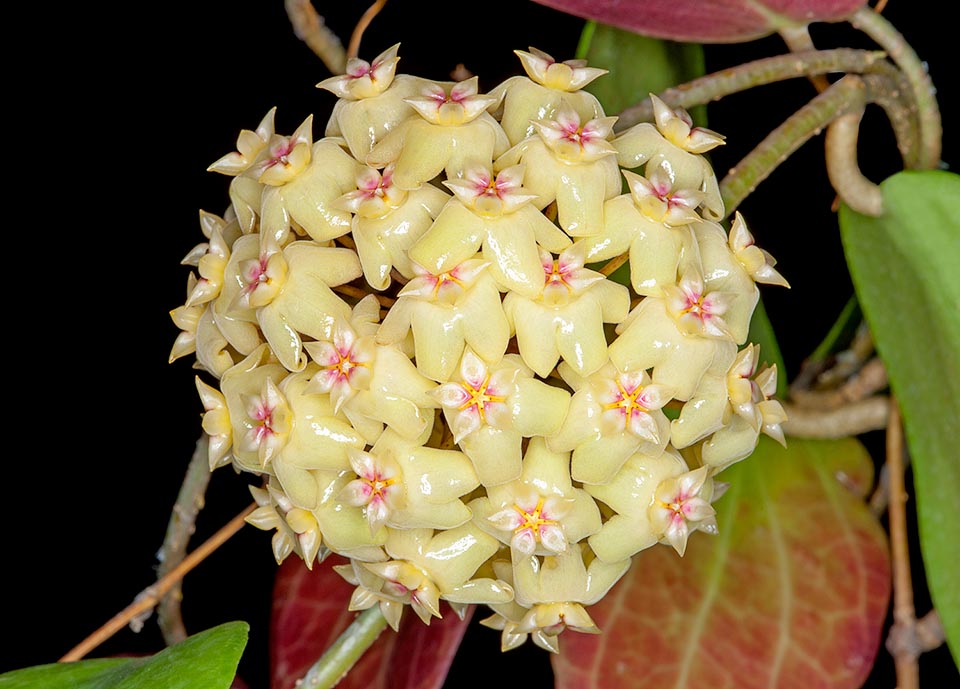Family : Apocynaceae

Text © Pietro Puccio

English translation by Mario Beltramini
The species is native to the Solomon Islands where it grows in the humid forests.
The genus is honoured to Thomas Hoy (ca. 1750-1822), botanist and curator of the gardens of the duke of Northumberland; the species is dedicated to the English collector, Rev. Richard Blundell Comins (1848-1919).
The Hoya cominsii Hemsl. (1891) is an evergreen climbing species with long stems provided with adventitious roots with which it anchors on the supports. The leaves are simple, opposite, ovate-elliptic with apiculate (that narrows abruptly in a short and pointed tip) apex and entire margin, fleshy and glossy, of intense green colour, that in presence of high luminosity get a reddish shade, with palmate prominent veins of pale green colour, 12-15 cm long and 3-5 cm broad. Umbelliform axillar inflorescences bearing up to 35 stellate flowers, of 0,8-1 cm of diameter, fragrant, waxy, of pale yellow colour with pink centre; the peduncle is remontant, therefore is not to be cut after the blooming. The fruits are fusiform follicles containing numerous seeds provided at one extremity of a tuft of silky hairs (pappus) that have the task of favouring their dispersion through the wind.

Solomon Islands climber with adventitious roots, Hoya cominsii has leaves turning red when the luminosity is high. Even 35 perfumed 0,8-1 cm flowers © G. Mazza
It reproduces by seed, put superficially on draining loam maintained humid at the temperature of 24-26 °C. At amateur level usually propagates by cutting, provided with 2-4 nodes, in late spring or early summer, in loam with addition of siliceous sand per a 30% or agriperlite maintained constantly humid, but without stagnations, and by air-layering.
Vigourous species cultivable in open air in the tropical and subtropical climate regions in very luminous position, also some hours of direct sun in the morning, elsewhere is to be cultivated in pot, even suspended, to be sheltered during the winter months in a protected ambient at the maximum possible luminosity and with lowest temperatures not under the 16 °C. It needs a very porous and draining substratum, being easily subject to root rottenness, neutral or slightly acidic, and regular waterings in summer, but allowing the substratum to dry up before giving water again, with frequent nebulizations with non calcareous water at ambient temperature in presence of dry air and high temperatures. In winter the waterings must be almost stopped, eventually with sporadic nebulizations if the humidity is too low in order not to get the leaves wrinkled. Monthly fertilizations, in spring-summer, with hydrosoluble balanced products, with microelements, at 1/3 the dosage shown on the package. The repottings are to be done when the substratum displays marks of deterioration and insufficient drainage, preferably between late spring and early summer, maintaining the new substratum dry for various days, until the first signs of vegetative regrowth.
→ To appreciate the biodiversity within the APOCYNACEAE family please click here.
